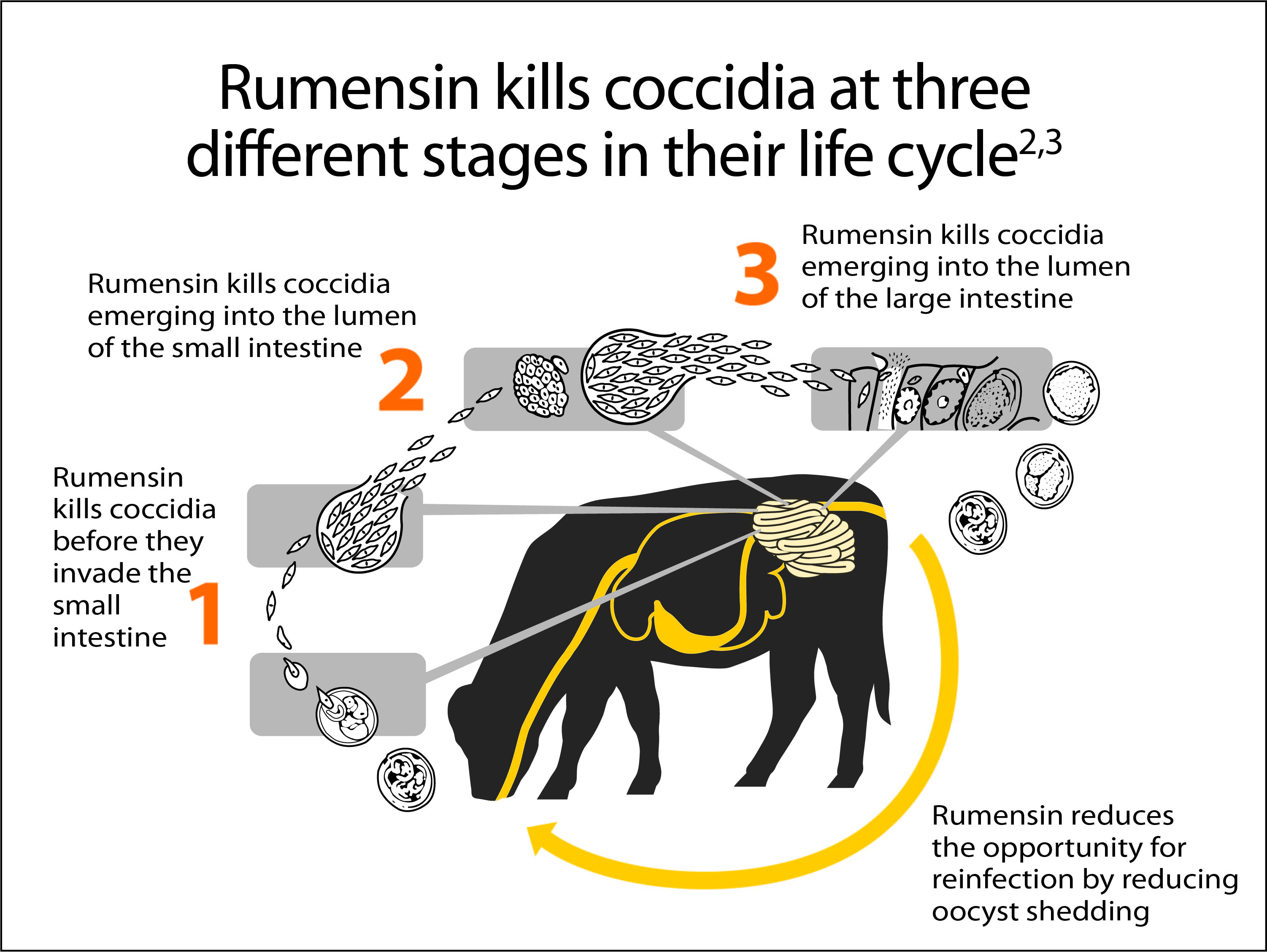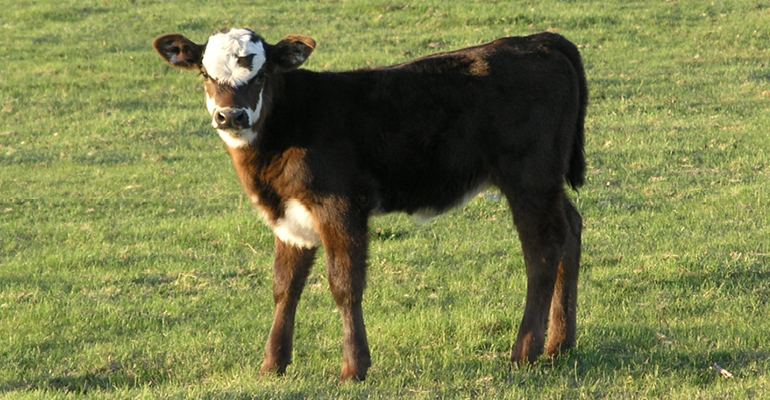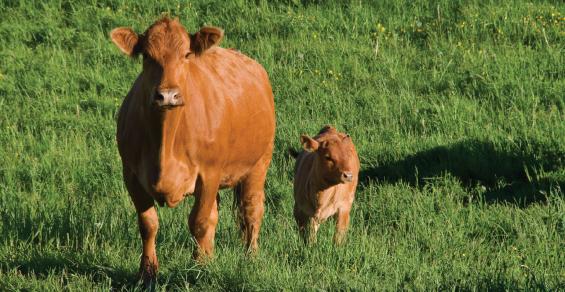Each year, the worldwide cost of clinical coccidiosis is around $400 million, which includes animal loss, veterinary expense and disease treatment.1 What this doesn’t include are the hidden costs associated with subclinical coccidiosis, including impaired growth or loss in feed efficiency.1
“Coccidiosis is a rather common subclinical disease,” said W. Mark Hilton, D.V.M., DABVP and Elanco technical consultant. “Recently weaned calves experience a lot of stress, and subclinical coccidiosis adds to the calf’s stress. Coccidiosis will impact the immune system negatively, which means the calf has a greater chance to get other diseases, such as bovine respiratory disease.”
When coccidiosis is under control, cattle tend to have better immunological response, which makes vaccines work better, improves overall health and, potentially, makes antibiotic programs more effective.
“Coccidiosis can have a big impact on your clients’ operations,” said Doug Hufstedler, Ph.D. and Elanco District Manager. “By having a plan in place to prevent and control coccidiosis, we can focus on addressing other animal health issues.”
Coccidiosis control
For over 40 years, cattle producers have relied on Rumensin® to control and prevent coccidiosis and improve feed efficiency. Rumensin kills coccidia parasites at three different stages in their life cycle, instead of simply slowing their development.2,3

“Compared to other ionophores, Rumensin is more efficient at lower doses per pound of body weight,” said Hufstedler. “Because Rumensin is the most potent feed ingredient available for coccidiosis prevention and control, it helps increase average daily gain (ADG) by providing more energy from the ration.”4
Improved gain with less inputs
Studies have shown that Rumensin helps deliver consistent value by reducing supplementation costs without negatively impacting performance.5 In a two-year study conducted in Oklahoma, Rumensin outperformed the other groups, delivering improved ADG and increased profitability while consuming less mineral.5
“One of most important things to help assure the health of a newly-weaned calf is to provide them with the best possible nutrition,” said Hilton. “Elanco encourages veterinarians to build a relationship with their clients’ nutritionists to help them create an ideal ration. If the nutrition is excellent, calves are much more resistant to disease.”
For more information on helping your clients manage coccidiosis while also improving weight gain, reach out to your Elanco sales representative or technical consultant.

The label contains complete use information, including cautions and warnings. Always read, understand and follow label and use directions.
CAUTION: Consumption by unapproved species or feeding undiluted may be toxic or fatal. Do not feed to veal calves.
Rumensin: Cattle fed in confinement for slaughter
For improved feed efficiency: Feed 5 to 40 g/ton (90% DM basis) continuously in a complete feed to provide 50 to 480 mg/hd/d.
For the prevention and control of coccidiosis due to Eimeria bovis and Eimeria zuernii: Feed 10 to 40 g/ton (90% DM basis) continuously to provide 0.14 to 0.42 mg/lb of body weight/d, depending upon severity of challenge, up to a maximum of 480 mg/hd/d.
Rumensin: Growing cattle on pasture or in dry lot (stockers, feeders, and dairy and beef replacement heifers)
For increased rate of weight gain: Feed 50 to 200 mg/hd/d in at least 1.0 lb of Type C medicated feed. Or, after the 5th day, feed 400 mg/hd/d every other day in at least 2.0 lbs of Type C medicated feed. The Type C medicated feed must contain 15 to 400 g/ton of monensin (90% DM basis). Do not self-feed.
For the prevention and control of coccidiosis due to Eimeria bovis and Eimeria zuernii: Feed at a rate to provide 0.14 to 0.42 mg/lb of body weight/d, depending upon severity of challenge, up to a maximum of 200 mg/hd/d. The Type C medicated feed must contain 15 to 400 g/ton (90% DM basis).
Free-Choice (Self-Fed) Medicated Feeds: Approved supplements must provide not less than 50 nor more than 200 mg/hd/d of monensin.
Rumensin: Mature reproducing beef cows
For improved feed efficiency when receiving supplemental feed: Feed continuously at a rate of 50 to 200 mg/hd/d. Cows on pasture or in dry lot must receive a minimum of 1.0 lb of Type C medicated feed/hd/d. Do not self-feed.
For the prevention and control of coccidiosis due to Eimeria bovis and Eimeria zuernii: Feed at a rate of 0.14 to 0.42 mg/lb of body weight/d, depending upon severity of challenge, up to a maximum of 200 mg/hd/d.
Rumensin: Calves
For the prevention and control of coccidiosis due to Eimeria bovis and Eimeria zuernii: Feed at a rate of 0.14 to 1.0 mg/lb of body weight/d, depending upon severity of challenge, up to a maximum of 200 mg/hd/d. The Type C medicated feed must contain 10 to 200 g/ton of monensin (90% DM basis).
1Jolley, W. and Barsley, K. (2006). Ruminant coccidiosis. Vet. Clin. Food Anim., 22, 613-621.
2McDougald, L. (1982). Chemotherapy of coccidiosis. The Biology of the Coccidia, 373-427.
3Long, P. and Jeffers, T. (1982). Studies on the stage of action of ionophorous antibodies against Eimeria. J. Parasitology, 68(3), 363-371.
4Bergen, W. and Bates, D. (1984). Ionophores: their effect on production efficiency and mode of action. Journal of Animal Science, 58, 1465-1483.
5Horn, G., and Gibson, C. et al. (2001). Two-year summary: effect of mineral supplementation with or without ionophores on growth performance of wheat pasture stocker cattle. Proc. Wheatland Stocker Conference, A1–A19. (The economic analysis was conducted only in year two of the trial.)
Rumensin, Elanco, and the diagonal bar logo are trademarks of Eli Lilly and Company or its affiliates.
©2017 Eli Lilly and Company or its affiliates.
ncfeed 6821-2 | USBBURUM00285




Leave A Comment